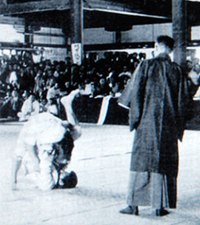Sankaku-jime
| Triangle choke | |
|---|---|

The triangle choke applied at an early judo tournament.
|
|
| Classification | Chokehold |
| Style | Judo |
| AKA | Sankaku-Jime |
| Parent hold | Guard (grappling) |
A triangle choke, or sankaku-jime (三角絞) in judo, is a type of figure-four chokehold which strangles the opponent by encircling the opponent's neck and one arm with the legs in a configuration similar to the shape of a triangle. The technique is a type of lateral vascular restraint that constricts the blood flow from the carotid arteries to the brain.
The triangle choke was seen in early kosen judo competition. While details of its origin are unknown, it is strongly associated to Yaichibei Kanemitsu and his apprentice Masaru Hayakawa, who featured the first registered use of the move in a kosen judo tournament in Kobe, Hyogo in November 1921. Earlier names for the technique would have been matsuba-gatame (松葉固め?), sankaku-garami (三角緘み?) or sankaku-gyaku (三角逆?) before finally settling down on sankaku-jime (三角絞め?). The sankaku-jime was officially adopted and endorsed by important judokas like Masami Oyama, and soon met plenty of use both in kosen judo and mainstream judo.Tsunetane Oda, a fellow kosen judoka, demonstrated the technique on video and is also credited with the creation of the move in some sources.
...
Wikipedia
